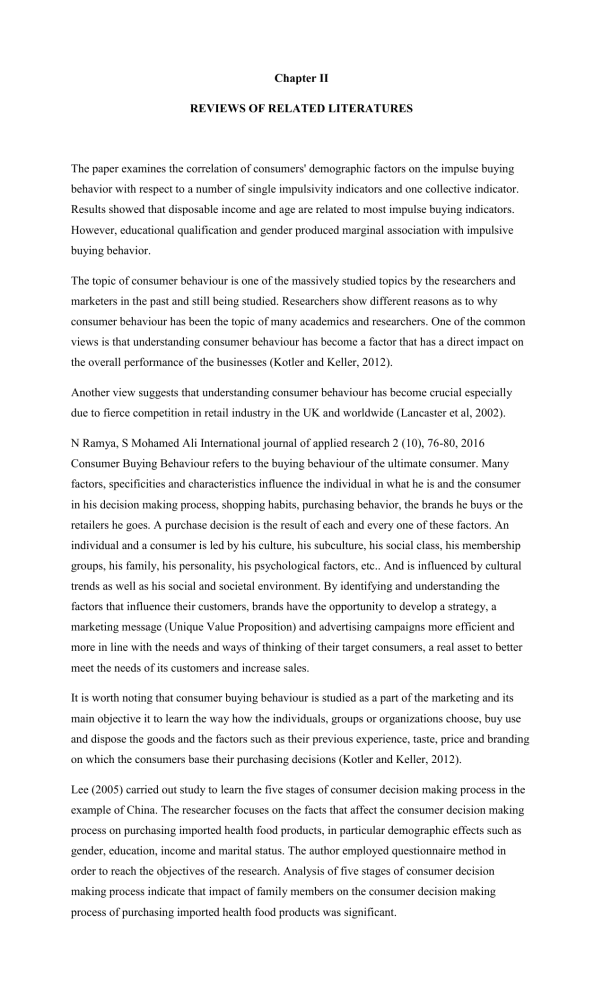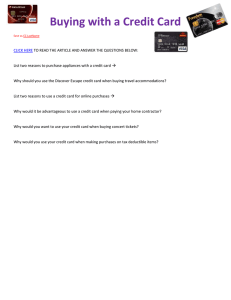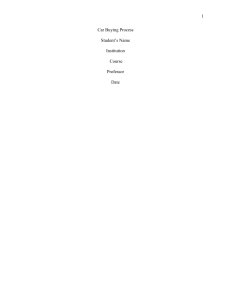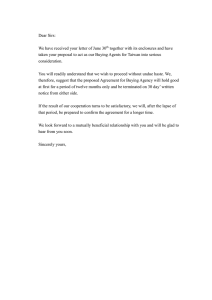
Chapter II REVIEWS OF RELATED LITERATURES The paper examines the correlation of consumers' demographic factors on the impulse buying behavior with respect to a number of single impulsivity indicators and one collective indicator. Results showed that disposable income and age are related to most impulse buying indicators. However, educational qualification and gender produced marginal association with impulsive buying behavior. The topic of consumer behaviour is one of the massively studied topics by the researchers and marketers in the past and still being studied. Researchers show different reasons as to why consumer behaviour has been the topic of many academics and researchers. One of the common views is that understanding consumer behaviour has become a factor that has a direct impact on the overall performance of the businesses (Kotler and Keller, 2012). Another view suggests that understanding consumer behaviour has become crucial especially due to fierce competition in retail industry in the UK and worldwide (Lancaster et al, 2002). N Ramya, S Mohamed Ali International journal of applied research 2 (10), 76-80, 2016 Consumer Buying Behaviour refers to the buying behaviour of the ultimate consumer. Many factors, specificities and characteristics influence the individual in what he is and the consumer in his decision making process, shopping habits, purchasing behavior, the brands he buys or the retailers he goes. A purchase decision is the result of each and every one of these factors. An individual and a consumer is led by his culture, his subculture, his social class, his membership groups, his family, his personality, his psychological factors, etc.. And is influenced by cultural trends as well as his social and societal environment. By identifying and understanding the factors that influence their customers, brands have the opportunity to develop a strategy, a marketing message (Unique Value Proposition) and advertising campaigns more efficient and more in line with the needs and ways of thinking of their target consumers, a real asset to better meet the needs of its customers and increase sales. It is worth noting that consumer buying behaviour is studied as a part of the marketing and its main objective it to learn the way how the individuals, groups or organizations choose, buy use and dispose the goods and the factors such as their previous experience, taste, price and branding on which the consumers base their purchasing decisions (Kotler and Keller, 2012). Lee (2005) carried out study to learn the five stages of consumer decision making process in the example of China. The researcher focuses on the facts that affect the consumer decision making process on purchasing imported health food products, in particular demographic effects such as gender, education, income and marital status. The author employed questionnaire method in order to reach the objectives of the research. Analysis of five stages of consumer decision making process indicate that impact of family members on the consumer decision making process of purchasing imported health food products was significant. Saraswat and et al. (2012), middle income group in Noida city, India are more likely to do impulsive buying because of economic reasons as promotional offers help in getting monetary benefits. Different dynamics of advertisement like advertisement of product in print and visual media, advertisement by celebrities, advertisement using 3-D effect, hoarding and pamphlets of product and event organized by the organization positively affect majority of respondents into Journal of Business and Social Sciences Research (JBSSR), Vol. 1, No. 2 220 impulse buying. This reflects a pivotal relationship between respondents’ impulse buying behaviors and impact of advertising campaign used in practice to enhance impulse purchase decisions. Ekeng and et al. (2012), demographic characteristics have a significant influence on impulse buying. Impulse buying differs significantly between male and female shoppers where the phenomenon is more common among female shoppers due to their likeness and spontaneous attraction to fancy products. Similarly age of shoppers and impulse buying behavior are inversely related because adolescents have no responsibility of raising families and they do not bother about the way they spend money even if it is unplanned as compared to older people. In addition, an increase in income of consumers makes them prodigal in spending and may influence to buy products unplanned. More educated consumers are likely to shop impulsively as they are influenced by their position and placement in society. Bashir and et al. (2013), the impact of Cultural Values and Lifestyle on Impulse Buying Behavior in case of Pakistan is positive. There is a significant relationship among all the variables of cultural values and life styles. The results also suggest that impulse buying behavior is predicted by security, life satisfaction, gender role, financial satisfaction, in group contact and lifestyle variables of cultural values and lifestyles of Pakistani consumers In the next stage, consumer searches information related to desired product or service (Schiffman and Kanuk, 2007). Information search process can be internal and external. While internal search refers to the process where consumers rely on their personal experiences and believes, external search involves wide search of information which includes addressing the media and advertising or feedbacks from other people (Rose and Samouel, 2009). Once the relevant information about the product or service is obtained the next stage involves analyzing the alternatives. Kotler and Keller (2005) consider this stage as one of the important stages as the consumer considers all the types and alternatives taking into account the factors such as size, quality and also price. Backhaus et al (2007) suggested that purchase decision is one of the important stages as this stage refers to occurrence of transaction. In other words, once the consumer recognized the need, searched for relevant information and considered the alternatives he/she makes decision whether or not to make the decision. Purchasing decision can further be divided into planned purchase, partially purchase or impulse purchase as stated by Kacen (2002) which will be discussed further in detail in the next chapters. Finally, post-purchase decision involves experience of the consumer about their purchase. Although the importance of this stage is not highlighted by many authors Neal et al (2004) argues that this is perhaps one of the most important stages in the consumer decision making process as it directly affects the consumers’ purchases of the same product or service from the same supplier in the future. Consumer buying behavior is a collection of decision-processes and subsequent behaviors, planned and unplanned, and determined by internal and external factors (Sharma & Sonwalkar, 2013). Risk and uncertainty are key components in the decision-process and consumer behavior in a risk-related crisis is driven by different factors for different consumer segments (Pennings et al., 2002). Drivers of consumer behavior in crises are commonly looked at from the perspective of consumers’ risk perceptions and risk attitude. Consumers have been segmented into “The panicked consumers”, “The prudent consumers”, “The concerned consumers” and “The rational consumers” (Amalia & Ionut, 2009). According to the same authors, in crises, such as an economic crisis, food crisis or terrorism related crisis, the panicked consumer tends to overreact and drastically cut spending whereas the prudent consumer carefully plans spending and postpones major purchases. The concerned consumers also plan their spending carefully, remaining loyal to certain brands, but they may be ready to try new and innovative products in spite of the hard times. The rational consumers in turn are not risk averse and their behavior remains essentially unchanged. Panic as a state of intense fear and high arousal may trigger major changes in consumer behavior (Duțu, 2020). When studying consumer responses to the swine flu (H1N1) threat, fear was highlighted as a key predictor of behavior change (Dedeoglu & Ventura, 2017) , and extreme reactions can obviously put companies in stressful situations (Amalia & Ionut, 2009) . Consumer behavior in crises is, however, not always consistent with the true level of risks (Pennings et al., 2002) , and therefore, the initial stages of a crisis may witness extreme behavior, which then gradually turns into more normalized behavior or possibly a “new-normal behavior”




